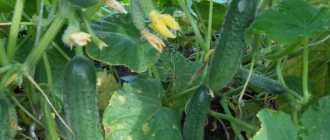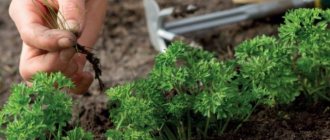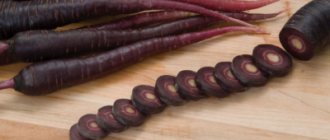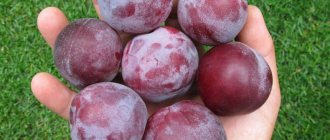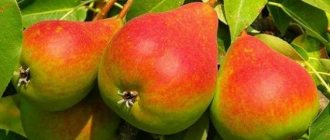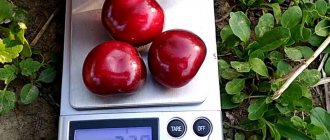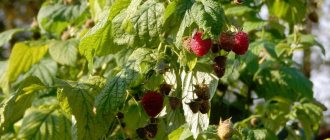Origin of the variety
The Chantanay carrot was bred by French breeders. This variety is considered a standard, an example of culture. On its basis, other varieties were developed, many of which include the name Chantane. All representatives of this type have similar characteristics, appearance and taste.
This carrot was brought to Russia during the Second World War and was registered in the State Register as Shantane 2461. It is this carrot that is considered the ancestor of all Shantane varieties bred in Russia.
Royal
Another common species of the carrot family is Chantane Royal. It has slightly shortened, even fruits. Productivity up to 9 kg per square meter. It is highly resistant to diseases. Increased shoot formation is not a typical phenomenon for the Shantane Royal variety. Great for juicing and adding fresh vegetables to salads. Has the ability to persist for a long time.
Advantages and disadvantages of Shantane carrots
This type of carrot has become widespread due to its versatility in use and the ability to grow almost throughout the entire territory of Russia.
The advantages of Shantane include:
- productivity at 400 c/ha, which is quite a high figure;
- root resistance to cracking and branching;
- carrots are not prone to blooming in the first year of cultivation;
- possibility of planting on heavy and infertile soils;
- reduced requirements for care and attention during cultivation;
- resistance to the main types of diseases of umbrella plants;
- long shelf life (over 8 months) and the ability to transport over long distances.
The disadvantage of this variety is the observance of special storage conditions. But this applies to all types of carrots in general. Also, the harvest time should not be exceeded; this leads to a deterioration in the taste of carrots.
Description and characteristics of root vegetables
The early variety belongs to the Shantane variety. Almost simultaneous germination of seeds is noted; it very rarely shoots. Root vegetables have a plastic structure and are not prone to cracking. Although the variety is early, it stores well.
Tops
The tops are long, semi-spreading, light green in color. The leaves are large and medium dissected.
Did you know? The homeland of carrots is Afghanistan, where they grew wild and had a purple or, less often, white color. The root vegetable acquired its usual color thanks to Dutch breeders who did this for the Royal House of Orange, whose color is orange.
Fruit size and characteristics
The root vegetables are bright orange, shaped like a cone, and have a rounded tip. On average, one root crop is 15-18 cm in length and weighs 90-160 g, although specimens reaching 200 g are often found.
The surface of the root crop is smooth, with a large number of eyes. The core is small in diameter, the pulp is dense and at the same time tender and juicy consistency. The vegetable has a high taste quality.
Contents of some substances in Kuroda carrots:
- dry matter - 10.5–15%;
- sugars - 10%;
- carotene - 20.5 mg.
Productivity
The variety has high yields: under normal conditions, from 1 hectare you can harvest from 23 to 42 tons of root crops. For comparison, the yield of the popular Losinoostrovskaya variety is 13 tons, and the ancestor of Kuroda Shantane is 4–8 tons lower.
The highest yield of the variety in Russia was established in the Krasnodar Territory - 436 c/ha. Of the entire harvest, the percentage of commercial quality products ranges from 85–96%.
Did you know? Eating carrots increases calcium levels in the blood and reduces cholesterol.
Harvest ripening time
The first Kuroda carrots ripen approximately 60–65 days after germination. Another month later, the harvest ripens in full. If you sow the seeds in April, in July you can already enjoy the ripe root crops of the new harvest.
Immunity to disease
Kuroda has good resistance to most diseases. Carrot immunity is especially successful in resisting various types of rot.
Varieties of Chantane
Based on the Chantenay 2461 variety, late, mid-season and early varieties and hybrids of carrots were developed. The name uses both a variant of Chantane and Chantenay.
Among the variety of new varieties and hybrids of Chantane, some that are included in the State Register should be noted:
- Kuroda Shantane. One of the sweetest early varieties with a sugar content of up to 10%. The yield of commercial products reaches 96%.
- Shantane 5. Has a large root crop, reaching 200 g and high yield. Mid-season variety.
- Chantenay A COURS ROUGE 2. Early ripening sweet variety with a sugar content of up to 10.5%. The root vegetable is small in size, weighing up to 120 g.
- Chantenay Royal. Quite a large carrot, gaining up to 180 g of weight, with a yield above the standard.
- Shanene Royal. Mid-season variety with large root crops. Productivity is average, up to 340 c/ha.
- Chantenay-Comet. Mid-early carrots weighing from 95 to 160 g.
Carrot Kuroda Shantane
Carrot Shantanay 5
Carrot Chantenay A COUR ROUGE 2
Carrots Chantane Royal
Carrot Shantanay Royal
Carrots Chantane-Comet
Chantenay is our family's favorite carrot. And this is not just a variety!
Carrots are one of the important crops in my garden. We grow it in large quantities, because... it is used for fresh summer consumption and for juices, winter storage, preservation, culinary processing throughout the year, and don’t forget about domestic birds - they also need vitamins for food :-) Over the course of six years, I have tested at least 30 varieties ( hybrids) and will try again, especially since the choice is now huge, for all tastes and needs. In this sense, IM Seedspost.ru is a paradise for lovers of variety and gardening experiments, the selection of seeds there is simply enormous, I’m glad that five years ago I came across this site on the Internet.
My carrot research goes in three directions:
- Firstly, I need carrots that can grow without problems and produce a reliable harvest in conditions of differences in day-night temperatures, very hot and dry summers, and without watering (or, in extreme cases, no more than 2 waterings per season .) And it would be nice if it were suitable for winter sowing, if I need it.
- Secondly, taste characteristics and juiciness are important, so that there is no bitterness and it is not woody or too hard.
- Thirdly, keeping quality is important, the possibility of winter storage for at least 6-7 months.
- A! It is also important that she grows large root crops, because... small and thin ones will not fit into a vegetable cutter for chopping for duck feed - they will slip between the knives of my unit :-). This, therefore, is the fourth thing.
So, through trial and error, I found out for myself that the Chantenay carrot is the most suitable in our climatic, soil and agrotechnical conditions, and also meets my requirements.
And when I say “chantenay,” I mean not just a variety, but a variety type, which is what it is, having become, so to speak, the “source” for a whole group of varieties and hybrids with similar external, taste and technical characteristics. Ads by
Examples from my research
Photos from the 2014 tasting, samples taken with average indicators in their variety (sorry, the photos are not glamorous, I took them for myself) 1.Flakoro, 2.Golden Autumn, 3.Carlena, 4.Candied fruit, 5.Delicatesnaya, 6.Giant Rossa , 7.Sugarfinger, 8.Refined sugar, 9.Orange ( Chantenay variety) The same as above, in cross-section Photos from the 2021 tasting:
1.NIIOKH 336 (dragée), 2.Rainbow F1, 3.Longe Rothe (Heartless ), 4.Nantes, 5.Chantaney royal , 6.Autumn joy, 7.Gourmet, 8.Chantaney
It was the carrots of the Chantenay variety that best suited all my requirements:
- Firstly, it is very flexible and resistant to adverse weather conditions; tolerates drought without watering - the short and thick root crop does not bend or branch in dry, drought-hardened soil; well adapted to heavy and not particularly fertile soils (we, of course, have black soil - but without watering and other “dances with tambourines”, the conditions for it are still Spartan); does not crack due to heavy rains after drought; frost-resistant - the group contains varieties (hybrids) that are recommended for winter sowing.
- Secondly, these are bright, deep orange or red-orange carrots, sweet and juicy - carotene and sugars are present in elevated levels throughout the group. The core is large, but also juicy, tender and tasty. The green shoulder is no more than 4 mm or absent at all, solanine is absent, and does not taste bitter. Early varieties are tender, juicy and sweet, mid-season and later varieties are denser and larger and are suitable for storage, but the taste is also high.
- Thirdly, the group contains varieties (hybrids) with good keeping quality for winter storage. On the Internet I have come across theses that it is not stored very well, but I have not encountered this myself. It seemed that this was written about one old variety and then reprinted by various resources. And now there are already many new hybrids of this variety with improved properties; selection does not stand still. I have a cellar under the house, it is warmer and more humid than I would like. But my carrots are still well stored there until the next season, and sometimes the old harvest is enough for summer feed for poultry, in general, it all depends on the weather during harvest and in the winter. Yes, there were situations when in March-April some carrots had to be discarded, but this did not only apply to the Chantenay variety.
- Well, such carrots are very good for food - because... it is not narrow and long, but short and wide, very convenient for cutting, and because of its juiciness and sweetness, ducks simply adore it :-) This is an excellent vitamin supplement for grain feed.
Carrot season - 2018
This year, among others, I grew the varieties Chantenay 2461, Chantanay, Apelsinka, Moskovskaya Zimnyaya A 515.
Unfortunately, the spring was cold and with frequent frosts, which is why the carrots sprouted very poorly at first and were stretched out, which didn’t even require special thinning, and then the summer, very hot and dry, also “hit” the harvest, so according to my estimates, I did not get 30% of the carrot harvest. But those that survived were of very good quality. There weren’t a lot of fines (mostly from Orange), she went straight to juices and cooking. Orange
Moscow Winter A 515 Orange Carrot, we cut the tops off in the field, during harvesting and scatter them over the beds
The Chantenay variety does not have branched root crops, but this season we found one - one for the entire harvest
The carrots are dried in the barn, sorted by size, small ones and those with damage are rejected (“eat right away” or “for the ducks”)
“Photo models” of the Chantenay variety were selected for weighing (the first in the row is most likely the “stranger” - the Delicatesnaya variety)
Weighing
According to the characteristics of seed producers, the weight of carrots of the Chantenay variety is expected to be in the range of 120-250 g, depending on the variety (hybrid), i.e. on average 150-220 g 454 g
558 g
490 g
383 g
For carrots of the Chantenay variety, the root length is 15-20 cm. Next year I will sow: the remaining seeds of this season, and also add (from the Chantenay variety) previously tried ones - to the Moscow Winter A 515 analogue on a tape (and compare which one will sprout better) and Kuroda Shantane, as well as the new Chance and Red Core.
Carrot seeds of the Chantenay variety in the Seedspost.ru store
Chantenay's ancestor was a wild carrot, rather dry and purple in color, native to the Middle East.
French breeders, by crossing and fixing the desired properties, developed a new hybrid, and in the middle of the 20th century it spread throughout Europe and also became popular here. Now there are at least 30 varieties and hybrids in this variety; the arsenal includes representatives with different ripening periods, which allows a very flexible approach to planning carrot sowings depending on needs and climate. Many of them are available in Seedspost.ru - these are seeds from Russian, Japanese, Dutch and French producers. 1. Early and mid-early varieties (hybrids): Kuroda Shantene, Shantane-comet, Teracotta F1, New Kuroda F1, Abaco F1, Orange.
2. Mid-season varieties (hybrids): Chantene, Shantene 2461, Grillage, Chantene Royal, Chance, Shantene Royal, Moscow Winter A 515, Boltex F1.
3. Mid-late and late varieties (hybrids): Red Core, Cupar F1, Cascade F1, Canada F1, Katrina F1, Canterbury F1.
We recommend!
The online store Seedspost.ru invites you to familiarize yourself with the Vegetable Seeds catalog, where you can choose and purchase seeds of any garden crops you like, including carrots.
Maturation period
Thanks to the huge number of varieties bred on the basis of Chantane, this type of carrot has both early, mid-season and late varieties available:
- Early varieties. The growing season of such carrots ranges from 70 to 100 days. It is sown in closed or open ground, if weather conditions permit, in late April - early May. Early carrots are intended for fresh consumption. These are the varieties Kuroda Shantane, Shantene A COUR ROUGE 2, Chantene-Komet, Abaco, etc.
- Mid-season varieties. Carrots ripen within 100-120 days. Sowing is done in open ground at the end of May - beginning of June. Mid-season carrots are usually the sweetest and are used for making juices and purees. It is represented by the varieties Shantane 5, Shantane 2461, Shantene Royal, Shantene Royal, Royal Chanson, Krasa Devitsa, Moskovskaya Zimnyaya, Catherine and others.
- Late varieties. These carrots are intended for winter storage. Its taste is not as pronounced as that of mid-season carrots, but it lasts longer. Some varieties are used for winter sowing. Late carrots are represented by the species Cascade, Abledo, Cupar, Canterbury, etc.
How to grow Shantane?
Also check out these articles
- Raspberry variety Maravilla
- What to feed the sheep?
- Radish Duro
- Cucumber variety Nezhinsky
Growing Shantane carrots is very easy. The planting location is chosen to be sunny; only “walking” partial shade is acceptable. Predecessors can be onions, tomatoes, cucumbers, cabbage and potatoes. Seeds are sown immediately in open ground or a greenhouse. The sowing period is in spring (mid-April - early May). In the southern regions and greenhouses, planting can be done from the beginning of April. Shantane, like other carrot varieties, is frost-resistant; in any case, late frosts will not harm the crops.
A groove 3-4 cm deep is dug, and seeds are sown in it in single file.
You can sow using any convenient method (on paper, with special machines that dispense seeds, etc.). More often it is simply sown in a row and later thinned out. To do this, dig a groove 3-4 cm deep, and seeds are sown in it in single file. It is important not to thicken the crops too much. Now all that remains is to sprinkle them with 2-3 cm of soil and water them. Watering is carried out from above, using a watering can with small holes so that the soil does not erode.
Productivity and planting characteristics
The yield of carrots of the Shantane variety is quite high. But the size of your harvest will depend on what growing conditions you create for the carrots. Good soil aeration, increasing its fertility, and the quality of crop processing will significantly affect the development of root crops, regardless of the variety.
Landing region
A large number of varieties of this carrot variety means it can be grown in various regions of our country. Covering the territory from the Southern regions to the Far East. When choosing carrots for planting, carefully study the packaging; it indicates the recommended growing zones.
| Growing region | Carrot varieties (Chantane variety) |
| Central | Abledo, Abaco, Cascade, Beauty Maiden, Coupar, Moscow Winter, Shantenay 5, Chantenay 2461, Chantenay Royal, Chantenay Royal, Royal Chanson. |
| Central Black Earth | Canterbury, Cascade, Catherine, Coupar, Chantenay 5, Chantenay 2461, Chantenay Royal, Royal Chanson. |
| Northwestern | Abaco, Canterbury, Cascade, Coupar, Moscow Winter, Chantenay 2461. |
| Volgo-Vyatsky | Abaco, Canterbury, Cascade, Catherine, Coupar, Chantenay 2461, Chantenay Royal. |
| North Caucasian | Abaco, Cascade, Kuroda Chantane, Cupar, Moscow Winter, Chantenay 2461, Chantenay A COURS ROUGE 2, Chantenay-Comet. |
| Middle Volga | Abaco, Canterbury, Cupar, Moscow Winter, Chantenay 2461. |
| Nizhnevolzhsky | Abaco, Canterbury, Cascade, Coupar, Chantenay 2461. |
| West Siberian | Abaco, Canterbury, Cascade, Coupar, Chantenay 2461. |
| East Siberian | Abaco, Canterbury, Cascade, Coupar, Chantenay 2461. |
| Ural | Canterbury, Cascade, Cupar, Chantenay 2461. |
| Far Eastern | Cascade, Coupar, Moscow Winter, Chantenay 2461, Chantenay Royal. |
| Northern | Chantenay 2461. |
Site selection and soil preparation
The choice of site for sowing carrots is of great importance for the yield and taste of root crops. Carrots are a light-loving crop and should grow in an unshaded place. Overwatering carrots during growth can lead to root rot. Therefore, it is desirable that the site has a slight slope to drain excess moisture.
There are varieties that produce crops in any soil. But if you want to get an excellent carrot harvest, the soil must be highly fertile and loose. This vegetable grows well on sandy and light loamy soils.
Crop rotation rules
Early cabbage and early potatoes, tomatoes, cucumbers, zucchini, and onions are considered good predecessors for carrots. You cannot apply fresh manure under carrots, so you should choose a plot with vegetables that were well fertilized in the previous season.
Crop rotation of carrots in the same area is carried out every 3-4 years. This avoids root aphids and nematodes and protects root crops from diseases common to carrots. Read more about crop rotation for carrots and other vegetables in this article.
Sowing technology
Carrots are sown in open ground or in a greenhouse. If the area for sowing is wet and groundwater passes close to the surface, then carrots are sown in ridges. In dry areas, sowing is carried out on a flat surface.
The row spacing varies from 25 to 45 cm, and the distance between root crops should be at least 5 cm. Seeds are planted to a depth of 0.5 to 2.5 cm, depending on the composition of the soil.
Seedlings will appear depending on soil temperature and soil moisture. If the temperature is 2-3 degrees, germination will take 25-30 days. At a temperature of 20-25 degrees, the seeds will hatch within 4-5 days.
Description of the carrot variety Shantane
The carrot variety Shantane is mid-season, ripens in 90-110 days. The yield is high; 5-9 kg of carrots are harvested per square meter. It is grown in regions with different climates and soil types. There is resistance to cracking. Curved, ugly specimens are very rare.
Chantane carrot fruits are smooth, conical with a blunt end, 10-15 cm long and 4-6 cm in diameter
The fruits of the carrot variety Chantane are smooth, conical with a blunt end, 10-15 cm long and 4-6 cm in diameter. The weight of one carrot ranges from 150-200 g. The root crops are completely immersed in the ground, the head does not turn green. The rosette is spreading, powerful, green. The color of carrots is orange, the flesh is dense, the stem part is weakly expressed. The taste is sweetish, very pleasant, children happily eat it even raw, without sugar. Contains 5.5-10% sugars, 25 mg of carotene per 100 g of product.
There are several varieties of the variety: “Chantane”, “Chantane Royal”, “Chantane Royal”, “Kuroda Shantane”, “Chicago F1”, “Skirskaya Shantane”, “Red Heart Shantane”, etc. All these subspecies have a similar appearance, characteristics, and cultivation methodology. But they also have obvious differences, so when choosing a variety you need to carefully study the seed packaging.
Growing and caring for carrots
No special care is required for carrots. Planted carrots will need to be thinned, weeds removed and watered regularly. By adhering to the agricultural technology of growing carrots, you will get an excellent harvest.
Watering
The carrot root goes deep enough into the ground, so this crop is drought-resistant and does not require frequent heavy watering. Regularly irrigate the soil, avoiding its drying out, only before germination. Once the carrots have sprouted, stop watering for 7-10 days to allow the roots to go as deep into the soil as possible.
You don't need to water your carrots often, but do it generously and evenly. In July-August, irrigate no more than once every 7-10 days. After each watering or rain, loosen the soil. Stop watering 2-3 weeks before harvesting to avoid cracking of the root crops.
You can find more information about watering carrots here.
Fertilizer application
Carrots respond very well to the application of fertilizers, both natural and mineral. In the fall, when digging up a site, it is advisable to add humus or compost (4-6 kg/sq. m) to the soil. When sowing on infertile soils, nitroammophoska (50 g/sq. m) is added to them. Fertile soils are not fertilized.
If you apply a lot of nitrogen fertilizers, this will worsen the shelf life of carrots.
During the growing season, plants are fed with nitrogen, phosphorus and potassium. Recently, many balanced multicomponent fertilizers have appeared for different crops, so choosing the right one will not be difficult.
Pest and disease control
To combat fungal diseases, fungicides are used, and diseased plants are destroyed. Pesticides are used to control insects that destroy carrot crops.
To prevent damage to carrots, observe proper crop rotation and do not thicken the plantings. Before sowing, the land must be completely cleared of plant residues. During the growing season, weeds are carefully weeded.
Control of carrot diseases:
- Fomoz. This disease cannot be cured. Remove any damaged plants. To prevent the appearance of Phoma, apply potassium-phosphorus fertilizers before planting.
- White rot. To combat this disease, spray crops with copper-containing preparations and apply potassium fertilizers.
- Gray rot. Treat the seedlings with Bordeaux mixture and fertilize with nitrogen fertilizers. Remove damaged plants.
- Rhizoctoniosis. Spray the plants with copper oxychloride.
- Black rot. Treat the plantings with fungicides containing iprodione.
- Bacteriosis. Incurable disease. Destroy the crops. For prevention, spray the seedlings with copper oxychloride.
Insect pests mostly attack the above-ground part of carrots. This leads to a lag in the development of root crops and a drop in yield. The following methods are used to control pests:
- Carrot fly. Treat carrots with pesticides. To prevent eggs from being laid in the ground, sprinkle it with a mixture of mothballs and sand.
- Carrot psyllid. Only manual collection of the eggs of this insect will help. Spray the crops with tobacco solution. Avoid planting next to coniferous plantations.
- Slugs. Add superphosphate to the top layer of soil and treat the plants with a solution of garlic, hot pepper and mustard.
- Wireworm. You can only get rid of it with the help of insecticides. Feed carrots with ammonia.
- Carrot aphid. Destroy weeds in the area in a timely manner. Spray the crops with a solution of ash and tobacco.
Features of care
Caring for carrots of the Shantane variety consists of several actions:
- regular loosening of the soil;
- weed removal;
- thinning;
- feeding;
- watering.
Care Tips:
- Carrots should never grow in a bunch, as they will become small and weak. That is why, during the first thinning, a distance of 4 cm is left between shoots, and during the second thinning, 8 cm.
- To ensure a juicy and sweet harvest, uniform watering should be ensured. To do this, use a watering can or hose with a sprayer. Young shoots are watered 2 times a week, adults - once a week.
- Feeding is carried out according to the following plan:
- a month after the formation of the first shoots, a nitrophoska solution is used (5 liters per 1 sq. m);
- 20 days after the first feeding, potassium and phosphorus compounds are used.
- Weeds are removed as they appear.
- Loosening must be done after each watering, otherwise a crust will form on the soil.
Harvest and storage
Carrot roots gain the greatest weight in September, so harvesting occurs late. You should stop watering carrots 2-3 weeks in advance. Cleaning is carried out in dry weather. The tops are cut off at the level of the head of the root crop. The carrots are left to dry in a shaded place outdoors.
Optimal conditions for storing carrot crops: air temperature 0 degrees. Relative humidity 95-96%. As the temperature rises, root crops begin to germinate. If the temperature has been lowered, then during thawing the root crop may be damaged by rot. Low humidity threatens that carrots will begin to wither.
Pros and cons of the variety
Despite the fact that the variety is young, experts were able to thoroughly study its advantages and characteristic disadvantages.
- Among the advantages are the following:
- excellent taste, the reason for which is the high content of sugars and carotene;
- high productivity;
- good resistance to a large number of diseases, especially rot;
- long shelf life, despite the fact that the variety is early;
- tolerates the vagaries of the weather well: heat, lack of precipitation, sudden changes in temperature.
As for the disadvantages of the variety, neither experts nor amateur gardeners mention the presence of significant disadvantages.
How to avoid mistakes when growing?
Although growing carrots is not difficult, novice gardeners can make some mistakes. This can lead to a noticeable decrease in carrot yield:
- Landing technology. Remember that carrots love rich, loose soil. Improve the land for planting as much as possible.
- Thinning carrots. A good powerful root crop will grow; it has enough space, at least 5-6 cm between plants. Carrots are thinned twice. The first time is in the phase of 2-3 leaves, leaving a distance between shoots of 1.5-2 cm. The second thinning occurs after 20-25 days.
- Proper watering. To prevent carrots from cracking, water them regularly. If irrigation has not been carried out for a long time, resume it gradually, in small volumes.
- Sufficient feeding. Avoid over-fertilizing as this will weaken the plant and increase the risk of disease.
- Hilling up plants. Don't forget about this important step. Carry out hilling at least three times during the carrot growing season. For most varieties of carrots, the head must be completely hidden underground, otherwise it begins to turn green and taste bitter.
Problems during cultivation and ways to solve them
If crops are not properly cared for, various problems can arise.
- If the plant becomes thin and the harvest is slow to appear, the root of the problem may lie in lack of weeding. Therefore, it is necessary to regularly weed and thin out the beds.
- Another common problem is the flesh being too hard and lacking taste. To avoid this, you need to water your carrots more often.
- If the fruits crack and deteriorate during storage, watering, on the contrary, should be reduced.
Reviews
★★★★★
Elena, 41 years old, housewife, Rostov. I planted carrots for the first time in my life last year.
They recommended the Chantenay variety. The carrots were born, just like a selection. I didn’t even expect it, because I thought that I wouldn’t be able to grow a good harvest the first time. ★★★★★
Oleg, 57 years old, gardener, Krasnodar region. I constantly plant Kuroda Shantane carrots.
She is very sweet and her grandchildren adore her. In addition, its germination rate is excellent, maybe you’re lucky with the seeds? But what has sprouted continues to grow. It doesn’t happen that one carrot is big and the other is small. ★★★★★
Tamara, 24 years old, Lipetsk. Our soils are rather heavy, the site is located in a lowland.
Therefore, I prefer to plant carrots that are not very long; they grow better in our garden. The choice was made on the Marlinka and Shantane varieties. Hide
Add your review
It is not for nothing that Chantane carrots are considered classic among other varieties of carrots. The versatility of use, the ability to grow throughout Russia and ease of care make this variety attractive not only for many gardeners, but also for growing on a large scale.
1
0
Copy link
Reviews of carrots Shantane
Maria Bevz : We have been planting this variety for ten years now, every year I buy a little more seeds so that we have them for future use. Chantane carrots are very sweet, which is why my grandchildren love them very much. It is not demanding in terms of care, I recommend it to everyone.
Evgeniy Bereza : Shantane carrots are stored very well in the basement, I plant a lot, then resell 30-50 kilograms to traders for preparing carrots in Korean. I don’t experiment with other varieties, as this one suits me in every way.
Svetlana Parkhomenko : I really love the Shantane variety of carrots, it is sweet, the flesh is very juicy, and the root crop is stored for a long time. I plant it in moist soil and sprinkle each hole with a little ash. During the summer I thin out, be sure to loosen the soil between the rows and remove weeds. I water it generously. The fruits of the Shantane carrot grow large, with a rich orange color.
Agricultural technology
Seeds are planted starting in mid-April. The place should be sunny. The ideal soil is humus-rich loam with a deep topsoil. But it can also grow on heavy soils, pre-treated. The depth of seed placement is no more than 1 cm. The distance between plants in a row is at least 5 cm. Row spacing is up to 20 cm. Carrots require watering only from the moment of emergence. After 4-5 true leaves appear, the frequency of watering is reduced, and if the amount of natural precipitation is sufficient, then you don’t have to additionally moisten the soil at all. Kuroda prefers phosphorus-potassium fertilizers with a small amount of nitrogen.
To get a second harvest, you can sow the seeds in mid-summer - the second half of July. You can sow before winter, and then in the spring you will get an early harvest.
Unpretentious, productive and very tasty, these carrots are in demand among lovers of early vegetables. The possibility of its long-term storage is also appreciated. The agricultural technology is quite simple; growing the variety will not cause much trouble.
Advice from experienced gardeners
Experienced vegetable growers who have been growing Kuroda carrots for more than one year recommend:
- To prevent carrots from cracking, in dry weather they are regularly spilled to a depth of 20-25 cm.
- To ensure that the root crops grow large and even, the plantings are thinned twice. The first time, an interval of up to 3 cm is left between the seedlings, the second - 5 cm.
- To protect carrots from carrot flies, marigolds or calendula are planted around the perimeter of the bed.
- A couple of times a season, carrots are fed with vegetable ash.
- Periodically, carefully loosen the soil, trying not to touch the root crops.
Pests and diseases
To avoid carrot diseases in the early stages of the growing season, biological products of the fungicidal group are used: TNTD, Abita-PIK.
Rot, bacteriosis, and cercopsoposis can worsen the taste and appearance of the carrot crop—these are the most common problems.
Fomoz (dry rot) manifests itself in the form of brown spots on the root crop, which grow, turn black, forming voids.
White rot is a common enemy of root crops. This fungus forms a whitish coating on the surface of carrots, the affected areas loosen, and the fruit becomes watery.
Brown leaf spot is a common cause of death in carrots. Constrictions appear on the petioles of a rusty color. On mature plants, the leaves curl. On root crops, the disease appears as small, light brown spots. A sharp boundary between the affected and healthy tissue is visible.
Black rot (alternaria blight) is especially dangerous for young plants, as it causes their mass death. Damage to adult plants manifests itself in darkening and curling of the tops. Subsequently, yellowish spots appear, gradually the leaves droop and dry out. On root crops it is expressed by areas of black dry rot.
Powdery mildew. We risk getting small, coarse root vegetables due to powdery mildew. Although plants survive this pest, the threat to the crop is enormous.
How to prevent diseases? Avoid rotting vegetation in the beds; apply phosphorus-potassium preparations before sowing. A good effect is achieved by treating with 1% Bordeaux mixture and using fungicides on the 20th day after germination.
In addition to infectious and fungal diseases, carrot pests cause great harm to root crops.
The bronze tint of the tops indicates that the root crop has been damaged by the carrot fly, the main pest of carrots. The fight against it is carried out with chemicals: Decis, Arrivo, Aklelic. As a preventative measure, deep plowing is suitable to destroy larvae overwintering in the soil, as well as mandatory weeding. Before sowing, to control pests, carrot seeds are treated with special agents: trichdermin, phytocide -r, azotophyte.
